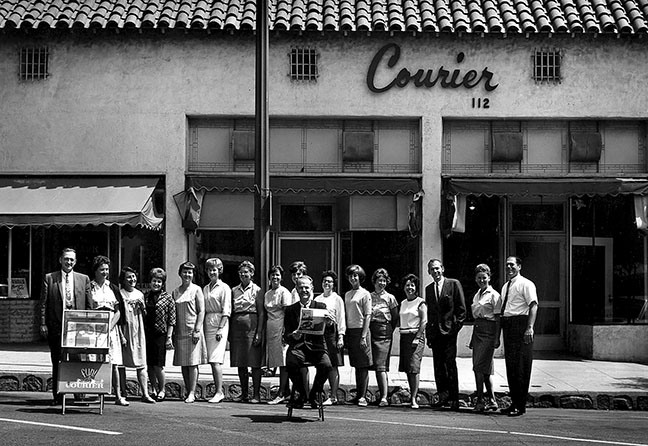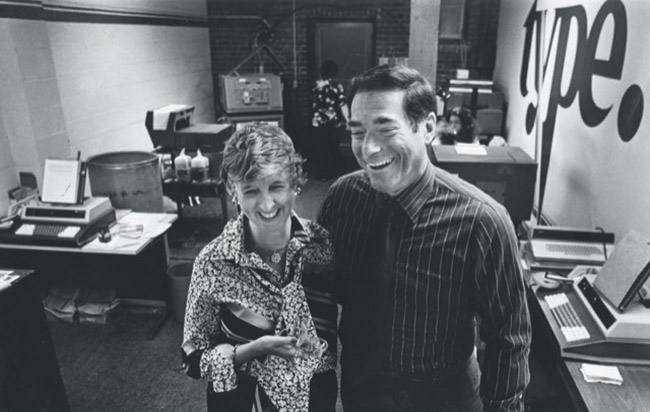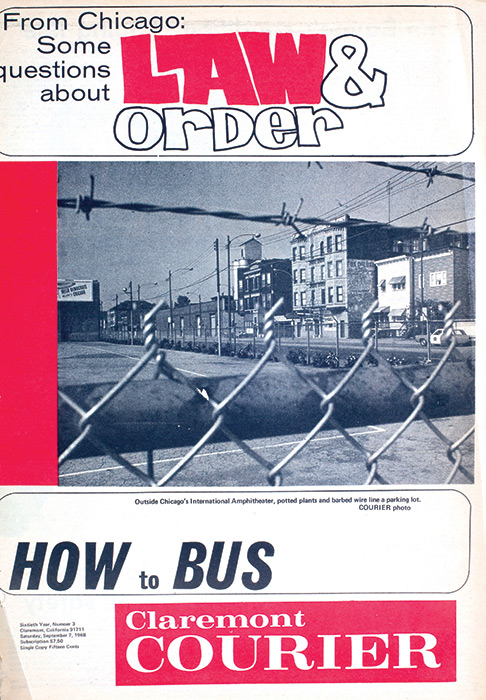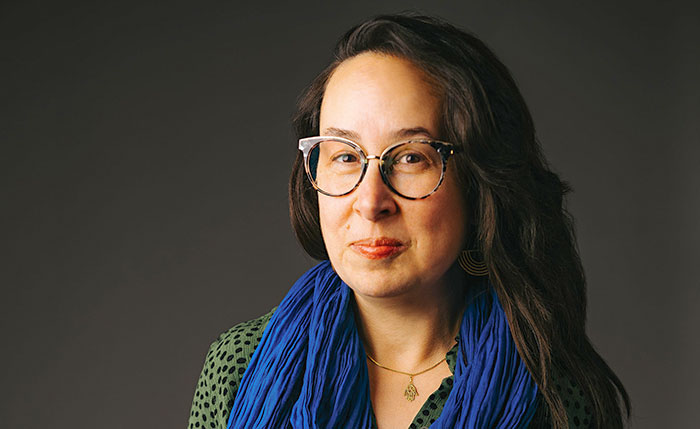Courier Chronicles: growing up in the Courier newsroom

Publishers Martin and Janis Weinberger are seen at right in this circa 1962 photo taken outside the former Courier offices at 112 Harvard Ave., now home to Crème Bakery and The Village Postmark. Stan Larson, from whom the Weinbergers purchased the Courier in 1955, is seated in front. Courier file photo
by Peter Weinberger | pweinberger@claremont-courier.com
I’ve considered myself quite fortunate to live in Claremont, with two loving parents who supported me. Growing up as the only son of Martin and Janis Weinberger exposed me to life as a member of the press at a very young age. I was able to see firsthand the impact of the printed word, a compelling photograph, and the power and responsibility of publishing local news. This experience defined who I am today. Here are some of those stories.
Voice from above
The Courier office was located at 112 Harvard Avenue for 25 years until moving to College Avenue in 1984. We worked out of two offices back then, where Crème Bakery and The Village Postmark exist today. The office layout was simple, with the main office, which included the newsroom and the business side employees, open to the public.
Courier newspaper production was next door. Back in the 1960s and 1970s, we needed an entire office for all the typesetting equipment, a photo darkroom, tables for pasting up Courier pages, and more. Both offices were connected by an open door. There were around 20 employees — about twice as many as today — because more people were needed to layout and produce the print edition twice weekly.
Martin Weinberger’s office truly made this location unique. It was located at the back of the newsroom space, with stairs leading up to what looked like an attic. It was more than large enough to accommodate Martin with all his books, newspapers, and other materials that comprised his organized clutter. Most employees would not venture up there unless Martin needed to chat with them in private. At the tender age of nine and growing, I would do my homework up there with dad.
Martin’s office also gave him the perfect perch from where to view everything going on below. That included keeping a watchful eye on any customer coming into the office. When he started writing, you could hear the echo of the tap-tap from his manual typewriter keys throughout both offices.

Jan and Martin Weinberger inside the Courier’s standalone production office at 112 Harvard Avenue in 1975, 32 years before computer pagination was used to design and edit the newspaper. Courier file photo
When he was sitting at his desk it was easy to forget he was even there. I had to be careful about having any personal phone conversation with good ol’ dad hovering over my shoulder, especially since he would not hesitate to join in on any discussion. His big, boisterous voice echoing off the walls could cause anyone to jump if not prepared. And often it was my mother Janis, always inside working on various projects, who was most unprepared for the booming voice from above.
“Janis, did you pay that printing bill?” “Janis sweetheart, has the mayor left any messages?” At times she literally had to wave him off to be quiet when on the phone or talking to a customer. And then the loving husband voice would kick in: “Janis dear, are we going to meet up with the Munters tonight?”
Of course, my mom was the only person who could “Yeah, but” Martin if he needed correction. Even as they would have a conversation from the first and second floors. “Honey, I’ve told you three times about tonight’s dinner, so please leave the office by five. We’re going to an amazing restaurant!” “Amazing” was my mother’s favorite word and could be inserted into any sentence.
As he got older, Martin finally did tone down broadcasting his voice from his office perch. I was told that one time he seriously shook up a customer who wasn’t prepared for his voice from above.
1968 Democratic National Convention
My parents absolutely loved going to national political conventions. Over their lifetime, Martin and Janis attended at least a dozen, both Democrats and Republicans, always reporting on their exploits in the Courier. They would attend as official press, just to sit through days of political yammering.
Given the significance of the 1968 Democratic National Convention in Chicago, Martin wrote two My Side of the Line columns, took pictures — he even mailed film back to Claremont — and devoted several pages of Courier newsprint to covering the event. This type of coverage was one example of what made the Courier special for our readers.
This time however, Martin and Janis took their son, who at 12, was not overwhelmed with excitement at the prospect of listening to politicians talk for four days. But Chicago was different. It seemed everything from inside the convention halls and outside on the streets was literally one continuous protest or fight. I remember seeing thousands protesting, rioting, barking dogs, barbed wire fencing, police on every street corner … all right outside the amphitheater where the convention was held.

About 3,000 young protesters confront 1,200 Illinois National Guardsmen — rifles at the ready — in Chicago’s Grant Park on Aug. 28, 1968. A march from the park to the convention later that day turned into what authorities called a police riot. This was the same day a 12-year-old Peter Weinberger witnessed the rioting at the convention site that evening. Photo/courtesy of the Milwaukee Journal
If you remember, Chicago’s mayor back then was Richard J. Daley, who held office from 1955 to 1976. He was called “the last of the big city bosses” for good reason. Daley orchestrated a continuous stream of construction projects to build Chicago up through difficult times, was influential within the Democratic Party, and was close to then President Lyndon B. Johnson. Daley also had a reputation for sharp rhetoric and being tough on crime.
To keep order at the convention he brought in thousands of police, as well as the National Guard. What the nation saw on their television screens during the convention was a steady stream of protesters getting beaten by police. It was not a good look for the Democrats.
On the third night, I witnessed thousands inside yelling “Daley must go! Daley must go!” They were McGovern supporters upset over the violent handling of the protesters. During a break I asked mom if I could go look for political freebees like bumper stickers, pens, buttons, and other items. We had spent a lot of time inside the building, so I knew how to get around the convention halls. I was given just 30 minutes to score some bling and come right back.
Making my way to the ground floor, I immediately noticed the noise outside getting louder and louder. As any curious kid might do, I opened a door to outside and was blasted by sounds of screaming, yelling, and pushing, as police confronted the protesters. I clearly remember seeing bloodied people being hit over and over with batons as they were dragged into police vans. It was like watching a movie. I froze but was not scared. I just stayed close to a store selling Hubert Humphrey posters.

After returning from the 1968 Democratic National Convention, Martin Weinberger wrote a news story and column about the use of force during the event. Courier file photo
What seemed like just a few minutes was probably was a lot longer as I lost all sense of time. The confrontations continued as I stood up against a wall holding a big bag of Humphrey gear. Luckily I got a better grasp of the situation when a nice gentleman asked me if my parents knew I was here. Of course I said yes, but he really didn’t believe me. It did however get me thinking about returning to my seat.
Then like a bolt of lightning I felt a hand firmly grab my arm, pulling me inside with what seemed like the strength of the Incredible Hulk. I looked up and it was mom. She had somehow found me through all the people and commotion, frantic for the safety of her lost son — although for the record I did not feel lost. To this day, I do not remember a time mom was so visibly upset with me.
As you might imagine, this incident has been lodged in my brain for decades, making it easy to remember these details. The next time I would attend a national political convention was eight years later, as a photographer for the Claremont Courier.
Editor’s note: Courier Chronicles will be continued as an occasional My Side of the Line column in print and online.










0 Comments